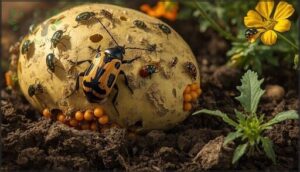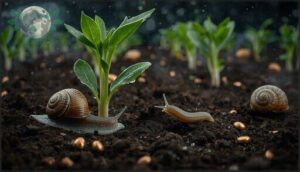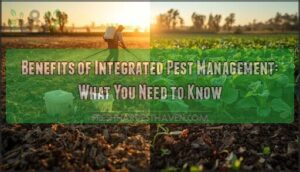This site is supported by our readers. We may earn a commission, at no cost to you, if you purchase through links.

Your tomato plant wilts overnight, pepper leaves curl into tight spirals, and something is turning your kale into lace. Vegetable garden pests don’t announce themselves with fanfare, but their damage compounds fast—aphids multiply into colonies of hundreds within two weeks, while a handful of cucumber beetles can vector diseases that wipe out entire plantings.
The $70 billion global toll from invasive insects reflects what every gardener discovers at ground level: unchecked pests don’t just nibble foliage, they dismantle months of work and slash yields by a third.
Fortunately, you don’t need synthetic chemicals to reclaim control—organic strategies built on accurate identification, timely intervention, and ecological reinforcements can stop infestations before they spiral.
Table Of Contents
Key Takeaways
- You can stop most vegetable garden pest damage by learning to identify common culprits—aphids multiply into colonies of 80 offspring within weeks, while beetles like the Colorado potato beetle can strip 86% of foliage and reduce yields up to 100%.
- Organic pest control methods like insecticidal soap and Bacillus thuringiensis deliver 90% mortality rates against soft-bodied pests and caterpillars within days, making synthetic chemicals unnecessary when you catch infestations early and rotate treatments to prevent resistance.
- Physical barriers like floating row covers shift your strategy from reactive to preventative, while introducing natural predators such as ladybugs (which consume over 60 aphids daily) builds a self-regulating ecosystem that controls pests season after season.
- Matching damage patterns to pest feeding styles—chewing insects leave holes, sucking pests cause yellowing without tissue loss, and boring insects create frass-filled tunnels—lets you pinpoint the exact problem and deploy the right targeted control before populations explode.
Identifying Common Vegetable Garden Pests
You can’t control pests if you don’t know what you’re dealing with. Learning to recognize the most common garden invaders by their appearance and feeding habits will save you time, money, and a lot of frustration.
Let’s break down the usual suspects you’ll encounter in your vegetable garden, starting with the tiny sap-suckers that multiply faster than you can blink.
Aphids, Whiteflies, and Mealybugs
You’ll encounter aphids, whiteflies, and mealybugs sucking sap from your plants, stunting growth and spreading viruses. A single aphid can produce 80 offspring in weeks, so monitoring thresholds matter—treat when 1–2% of plants show infestation.
Whitefly viruses can destroy entire crops, while mealybug damage includes yellowing and sooty mold. Insecticidal soap and organic controls work well if you catch them early.
Aphids can also cause damage by honeydew production.
Caterpillars and Cabbage Worms
Cabbage worms, cabbage loopers, and other caterpillars feed on brassicas like broccoli and kale, chewing ragged holes in leaves and leaving dark frass behind. Loopers reach 1.5 inches and move in distinctive arches, while imported cabbageworms grow velvety green with faint yellow stripes.
These pests are a significant economic concern because they can cause reduced crop yields. When 10% of your plants show larvae before heading, treatment with Bacillus thuringiensis delivers 90% mortality within six days.
Beetles (Potato, Cucumber, Bean, Flea)
Beetles represent some of the most aggressive pests you’ll face. Colorado potato beetle adults, with their black and tan stripes, can strip 86% of foliage and reduce yields by up to 100%. Cucumber beetles vector diseases while feeding, flea beetles punch shot-hole patterns in tender leaves, and Mexican bean beetles cause 16–52% grain loss in untreated plots.
Beetles are among the most destructive garden pests, capable of stripping entire crops and slashing yields by up to 100%
Five key beetle indicators:
- Striped or spotted wing covers measuring 1/4 to 1/3 inch
- Round feeding holes or complete defoliation patterns
- Orange eggs clustered on leaf undersides
- Tan or yellow larval stages feeding alongside adults
- Peak activity during July and August flowering windows
Resistant varieties, trap cropping with radishes or nasturtiums, and releases of predaceous stink bugs suppress beetle density by 62%. Monitor damage thresholds closely—potato crops tolerate 30% defoliation before flowering but only 10% once tubers form.
Natural predators like ladybugs and lacewings provide season-long organic pest control when you plant alyssum or yarrow to support their lifecycle needs.
Slugs, Snails, and Cutworms
Slugs, snails, and cutworms strike seedlings when you’re least expecting it. These nocturnal feeders can destroy 50 wheat-size seeds per slug within seven days, and cutworm larvae sever transplants at soil level during their nightly C-shaped patrols.
Organic baits like ferric phosphate, beer traps capturing five to six slugs over four days, and copper barriers provide seedling protection without synthetic chemistry, reducing stand loss by combining habitat modification with early detection.
Pest Identification by Damage Type
You can pinpoint which pest is terrorizing your vegetable garden by reading the clues left behind on leaves, stems, and roots. Field surveys show that matching damage patterns to feeding style narrows your suspect list fast, saving time and directing you toward the right organic control.
- Chewing symptoms create irregular holes, notched margins, or skeletonized plant leaves where only veins remain
- Sucking damage shows chlorotic stippling, leaf curling, and honeydew without missing tissue
- Boring tunnels filled with frass appear inside stems or fruit, causing sudden wilting
- Root damage reduces fine root density, triggering stunting even under adequate irrigation
- Abiotic mimicry requires close pest identification, since disease lesions stay within tissue while insect feeding removes it
How Pests Damage Vegetable Gardens
Understanding how pests actually harm your plants helps you spot trouble early and respond with the right strategy. These tiny invaders use different feeding methods that damage vegetables in distinct ways, from weakening foliage to spreading disease.
Let’s break down the four main types of damage you’ll encounter in your garden and what they mean for your harvest.
Chewing, Sucking, and Boring Insects
Not all vegetable garden pests attack plants the same way, and understanding their feeding guilds—chewing, sucking, and boring insects—lets you tailor your control tactics effectively.
Chewing insects devour leaves, sometimes causing complete defoliation, while sucking insects like aphids extract sap and trigger yellowing and stunting. Boring pests tunnel into stems and fruits, disrupting water flow.
Accurate pest identification through damage symptoms sharpens your IPM scouting and aids resistance management in organic pest control programs.
Disease Transmission by Pests
Beyond physical injury, many garden pests function as viral vector ecology specialists, shuttling plant viruses from sick plants to healthy ones. Aphids transmit roughly half of all insect-borne plant viruses, while whiteflies spread tomato yellow leaf curl virus that can obliterate your harvest.
Thrips spread viruses and nematode virus vectors introduce pathogens below ground. Bacterial wilt vectors like cucumber beetles deliver Erwinia that clogs vascular tissue, escalating disease severity factors and compromising plant health faster than fungal growth alone.
Root and Leaf Damage Patterns
Recognizing leaf damage and root crop injury early gives you the upper hand against garden pests. Visual signatures help you pinpoint culprits before they devastate your harvest.
- Leaf miner damage creates winding tunnels, reducing photosynthesis by up to 80%
- Root-knot nematodes slash tomato yields by 50%, producing galled, stunted plant roots
- Herbivory damage exceeding 20% weakens plant leaves, inviting secondary infections
Seedling collapse from cutworms or leafminers signals immediate intervention needs.
Economic Impact of Pest Infestations
Your garden harvest isn’t the only thing at stake—pests threaten your wallet and the broader food system. Globally, invasive insects cause over $70 billion in annual losses, while vegetable crop yields drop 10–30% from damage and post-harvest destruction.
Treatment costs for small-scale infestations run $100–$500 per session, and severe pest pressure disrupts market supply chains, undermining food security and global trade stability.
Organic Methods for Pest Prevention and Control
You don’t need synthetic pesticides to protect your vegetable garden from destructive pests. Organic methods work by targeting specific pests while preserving the beneficial insects and soil organisms that keep your garden ecosystem in balance.
Here are five proven strategies that form the foundation of effective, chemical-free pest management.
Insecticidal Soaps and Neem Oil
Two of your most reliable allies in organic pest control work in different but complementary ways. Insecticidal soap targets soft-bodied pests like aphids and whiteflies by breaking down their protective coating, achieving near-complete kill within 24 hours when sprayed directly. Neem oil takes a broader approach, disrupting feeding and reproduction across 400+ pest species.
Key advantages for your vegetable garden:
- Soap Spectrum: Highly effective against aphids, whiteflies, and mites with minimal environmental persistence
- Neem Efficacy: Controls caterpillars, beetles, and sucking insects while allowing sublethal suppression strategies
- Environmental Impact: Both conserve beneficial insects better than synthetics when timed properly
- Application Risks: Test on small areas first; phytotoxicity increases with concentration and heat stress
These products fit naturally into IPM programs, reducing pest pressure while you maintain ecological balance in your organic gardening system.
Bacillus Thuringiensis (Bt) and Spinosad
When soft-bodied pests resist soap and neem, you’ll need Bacillus thuringiensis and spinosad—two microbial-derived options that hit caterpillars and leaf-chewing insects hard. Bt produces crystal proteins that paralyze caterpillar guts, achieving roughly 90% mortality within six days on cabbage worms and tomato leafminers. Spinosad acts faster, hyperexciting nerve receptors to stop feeding within minutes and kill most targets in 24 hours.
| Product | Primary Targets | Speed of Action |
|---|---|---|
| Bt (Bacillus thuringiensis) | Lepidopteran larvae (caterpillars, cabbage worms) | 2–6 days for 90% mortality |
| Spinosad | Caterpillars, thrips, leafminers, beetles | Minutes to cease feeding; 1–2 days for control |
| Integrated Programs (Bt + spinosad) | Mixed infestations, resistant populations |
- https://www.agrivi.com/blog/yield-losses-due-to-pests/
- https://pmc.ncbi.nlm.nih.gov/articles/PMC9963591/
- https://extension.msstate.edu/publications/insect-pests-the-home-vegetable-garden
- https://brazos.agrilife.org/files/2025/06/E-194_AgriLife_managing-insect_mite_vegetable_gardens.pdf
- https://vegetablegrowersnews.com/article/2025-pest-survey-report/










